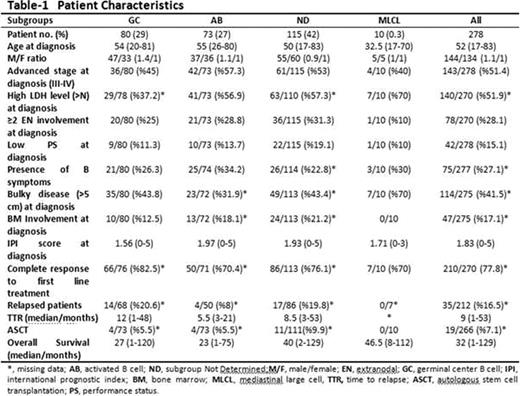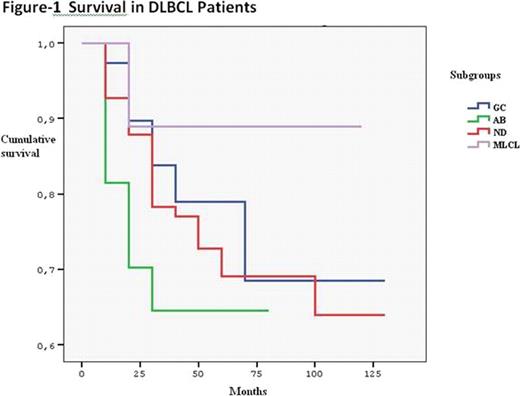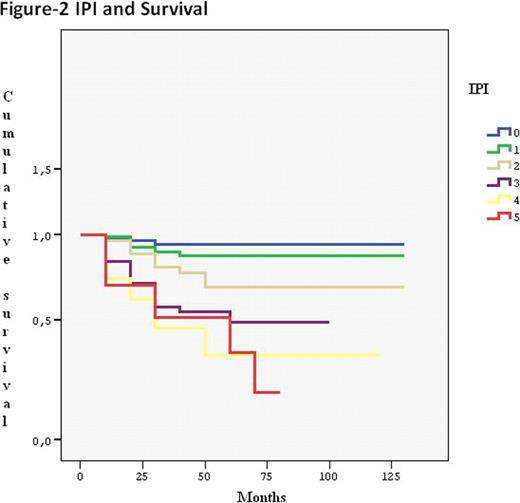Abstract
Abstract 5223
Non-Hodgkin's Lymphoma (NHL) is the most common type of hematopoietic cancers and it constitutes 4% of all cancers. It is the seventh most common type of all cancers in Turkey. The NHL is 1.5 times more common among males and the median age of most subtypes is equal to or more than 50. About 85% of NHL has B cell origin and 5-year overall survival is around 60%. Tumor volume, histology, patient's age and performance, serum lactate dehydrogenase (LDH) and beta-2 microglobulin levels, stage of disease and presence of extranodal disease are related to prognosis of NHL. International Prognostic Index (IPI) includes five of these factors to predict prognosis: patient's age and performance, stage of the disease, serum LDH level, extranodal disease.
The aim of this study is to evaluate the responses to actual treatments applied and survival periods of our Diffuse Large B Cell Lymphoma (DLBCL) patients. Non-Burkitt's, aggressive non-Hodgkin's lymphoma records obtained from our hematology department, which belong to the period between January 2000 and May 2011 were retrospectively analyzed. 278 patients diagnosed morphologically/immune-histochemically as CD20 positive DLBCL were included in this study. 153 of 278 paraffin blocks of diagnostic tissue were accessible and two subgroups of DLBCL were determined as Germinal Center B cell (GC) and Activated B cell (AB). From the remaining 125 cases, paraffin blocks of diagnostic tissue could not be accessed 115 cases, so any subgroup could not be determined (ND) and Mediastinal Large Cell Lymphoma (MLCL) were assessed in 10 cases. The subgroups were compared in order to evaluate the survival and also the responses to treatment. In the non-parametric comparison process, we used Mann-Whitney-U test.
Patient characteristics according to the subgroups are detailed in Table 1. Complete remission was achieved with the first line treatment in 75% of patients and from those, 20% were relapsed at the median of 9 months. Overall Survival (OS) was significantly longer in GC than in AB patients (median OS: 27 vs 24 months, p=0.006). The Time to Relapse (TTR) is two times longer in GC group than in AB group, however this data is not statistically significant (median TTR: 12 vs 5.5 months, p=0.221). Survival curve of ND patients is not significantly different from GC curve (p= 0.436). Nevertheless, AB subgroup survival curve is significantly worse than ND group (p= 0.024, Figure 1). Regarding all patients, IPI predicts the survival of DLBCL independent from subgroups and treatment modalities (p<0.001, Figure 2). The longest survival time is in MLCL patients, nonetheless statistical analysis could not be made because of the small number of patients.
The data should be analyzed carefully because all data could not be accessed in some patients as this is a retrospective analysis. However, our data is valuable at the point that it reflects “real-life” patient data.
This study was supported by Istanbul University Research Fund.
No relevant conflicts of interest to declare.
Author notes
Asterisk with author names denotes non-ASH members.




This feature is available to Subscribers Only
Sign In or Create an Account Close Modal